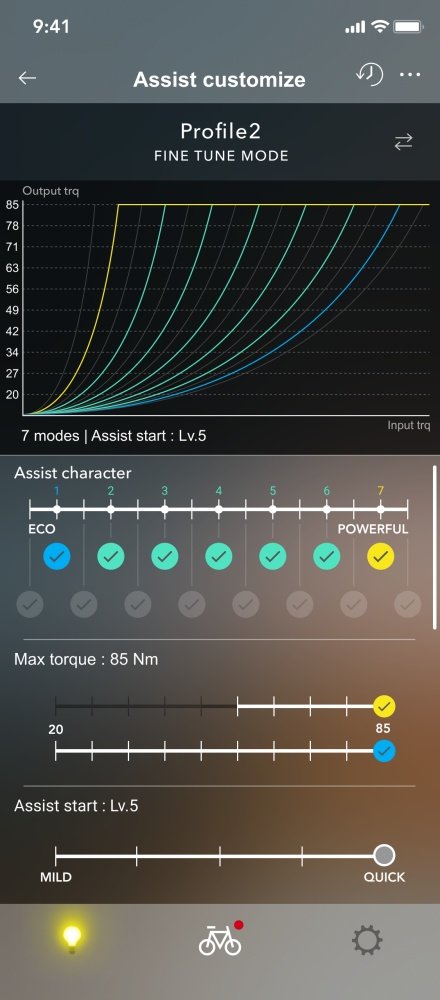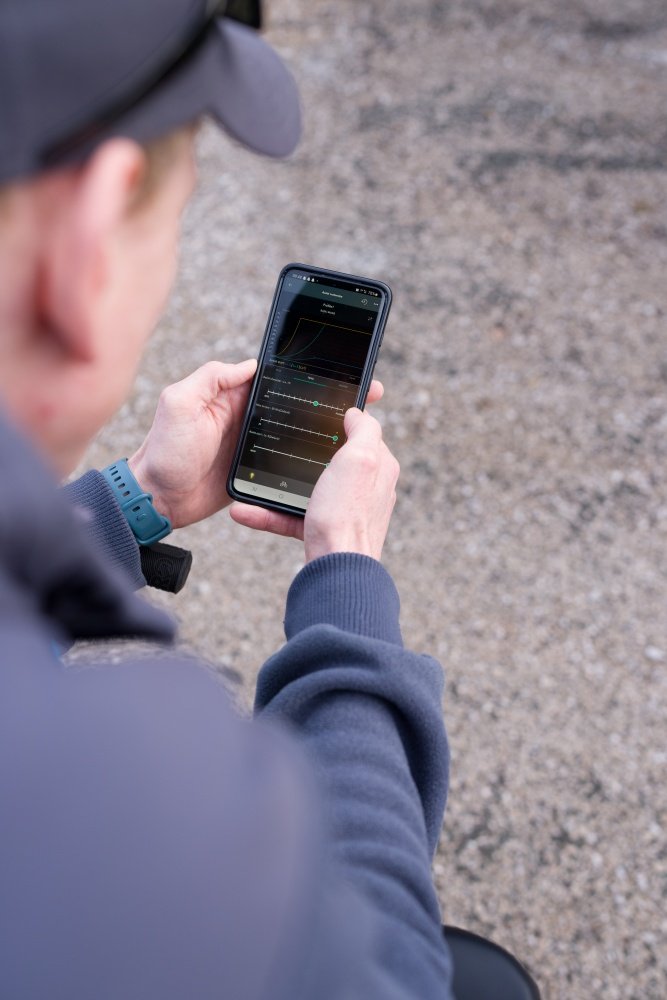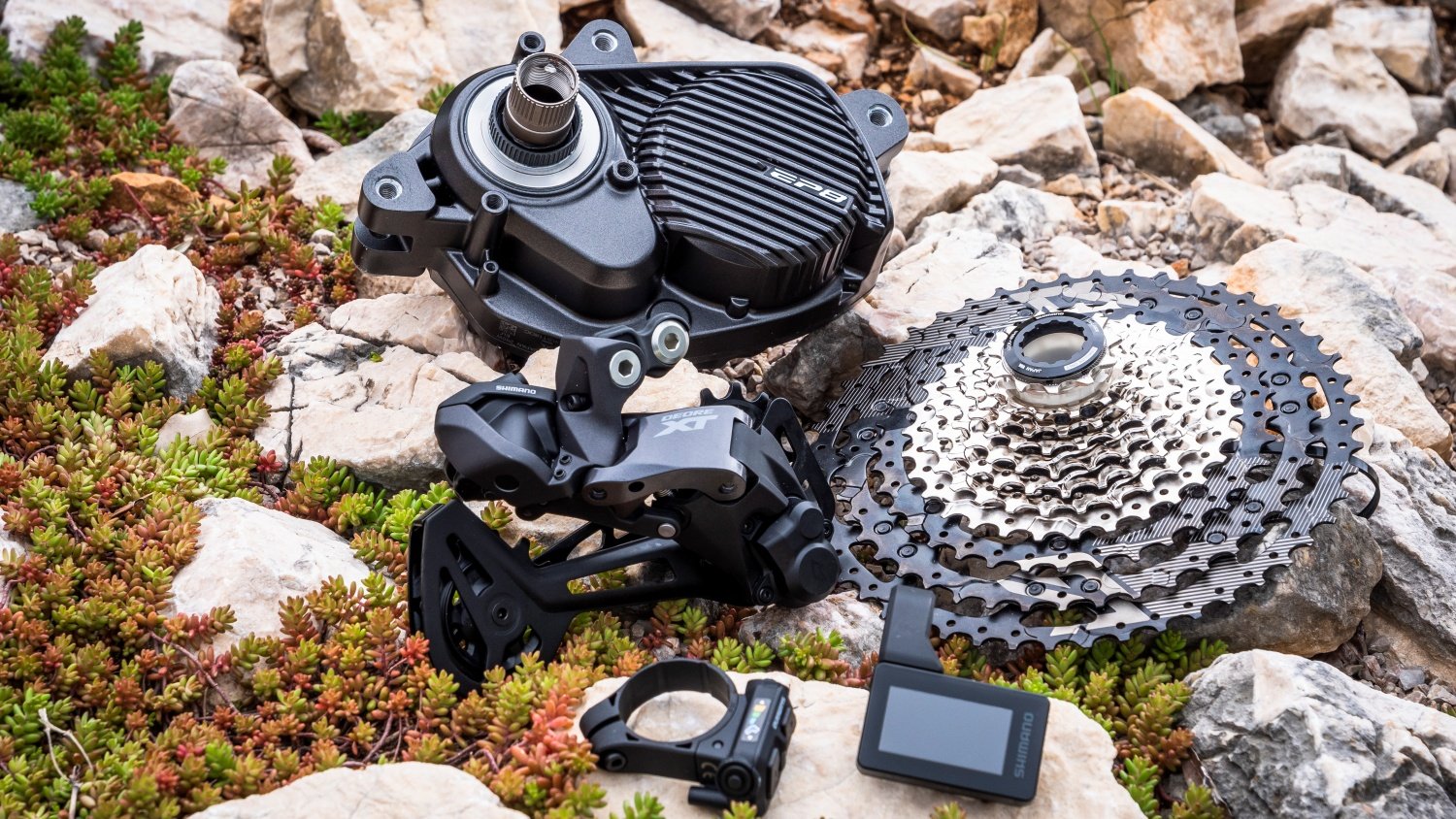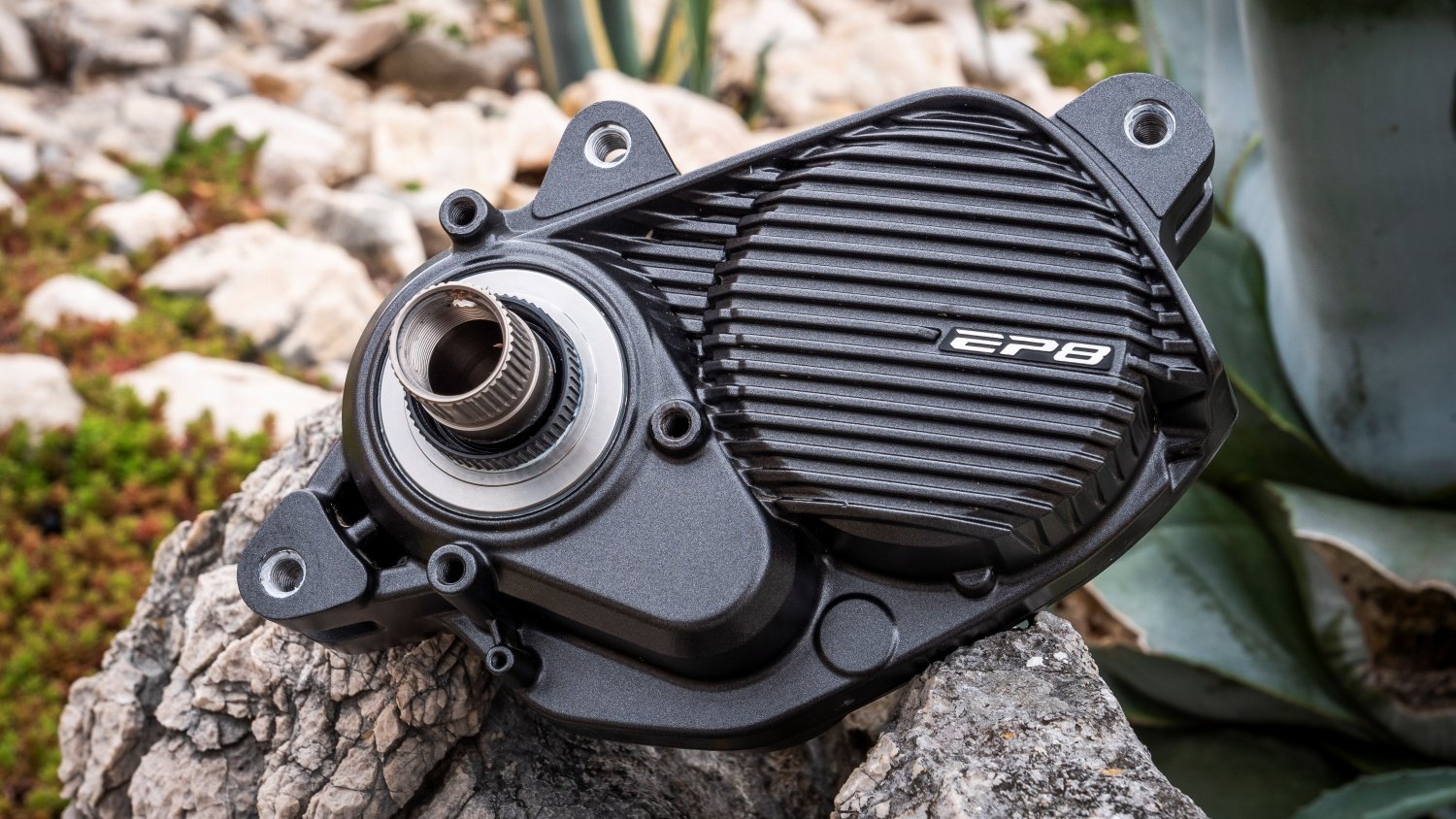We’ve had a couple of encounters with the new EP8 motor already. We rode it on a Yeti, and it was so quiet. Despite riding on frozen and noisy surfaces, we were quite confident this motor was silent.
Watch the video of our ride on the new Shimano motors, or keep reading below.
Shortly after, we got to do a quick ride on a 2023 Orbea Rise with the new EP8-RS. This time we heard a bit of rattle, undoubtedly. The noise wasn’t bad at all, the 2023 Rise was much more silent than the 2022 edition. Thanks to the motor and to improved internal cable routing.
-The motor needed a redesign to work with Auto Shift, the new automatic shifting system. (Read our test of the Auto Shift here.) Both the new EP8 and the EP6 have got additional hardware for the Auto Shift computing and for connecting the gear system. And while Shimano were doing changes to layout and motor parts, they used the opportunity to improve the rattle noise that can be audible while coasting.
Shimano have done changes such as altering the cut of the internal gears and adding a beefier seal for the crank axle bearing. They’re not claiming it’s a completely silent motor, they don’t make any promises about the noise level.

Shimano EP8 (801) and the new Di2 Linkglide system with Auto Shift. (Photo: Dan Milner)

Shimano EP8, code name EP801 (Photo: Irmo Keizer)

The original EP8, code name EP800.

Look closely and you can tell the two EP8 motors apart.

Shimano EP6, code name EP600.
The magnesium house found on the EP8 motors has been replaced with one made of steel on the EP6. Steel is cheaper and heavier, pushing the weight to about 3 kg. And that’s a good weight. It’s not too far off motors such as the Specialized 2.1 and Bosch Performance CX gen 4. The EP6 also gets Auto Shift compatability and all the changes done to improve motor rattle.

Lagging behind
I soon found myself at the tail of the peloton though. And I was pedaling quite hard. Wasn’t this supposed to be a chill transport section? Fredrik was riding a Santa Cruz Heckler with the EP801. And he was having a chill ride, hardly putting in an effort.
Could there be something wrong with the EP6 I rode? I doubt it. Switching bikes with Fredrik, we noticed the motor was cutting at a lower speed reported by the Shimano display. All the EP801 bikes were pulling away from the EP6. I believe this is the characteristic of the EP800 and EP6.

Photo: Irmo Keizer

Shimano EP8 (801) on the rocks.
The motor noise while pedaling isn’t bad at all on the Shimano EP-motors. There is no high pitched whine as we pedal hard at high cadence. Most 85Nm+ motors are a bit noisy, the EPs are among the more silent ones. There was some difference in noise levels between the three different bikes we rode, probably due to frame design and motor integration.
Riding the trails, Fredrik didn’t hear the motor rattle on any of the bikes. Neither did I. But we didn’t remember to listen for it while descending. The noise was there though, we heard it when playing back the Gopro footage. So, Shimano is right, the noise isn’t completely gone. In all fairness though, we didn’t notice it so it’s hardly a problem. Not for us.

Fredrik, a Bulls and the Shimano EP6.
Finetune Mode looks complicated. Activate all assistance levels and you end up with 15 different levels to chose from. It’s not that complicated though. You set the torque for the maximum and minimum assistance level, and the 13 other levels are distributed evenly between them.
You could have all 15 levels active if you want to, but I don’t think that’s the intention. The motor power ramps up faster for each level. You pick the levels with the desired ramp-up and power. That way you could end up with say 4 to 7 levels that suits your riding. And you can set up additional power profiles where you select different assistance levels for a different type of riding.
All assistance levels in Finetune Mode are what I call “static”. You get the same amount of power amplification regardless of how hard you pedal. The Trail level found in Basic Mode is a dynamic assistance level. It amplifies rider power more as one pedal harder. Shimano motors have little motor overrun. The motor doesn’t push much after you stop pedaling, making it easy to control. But the Boost level found under Basic Mode has more motor overrun than the other levels.

Riding Trail assistance in Basic Mode. EP800 display.

Traversing on a Santa Cruz Heckler and the EP8 (801) - (Photo: Irmo Keizer).
The EP6 is a pleasant motor. Noise levels are equally as good as on the new EP8. If you’re not pushing it, riding as fast as possible, the EP6 feels nice and powerful. But it could be dropping off a bit sooner than other brands. It feels like there is some sacrifice at the top end. I never really notice unless I’m riding at cut-off speed in a group though. The EP6 is great for riding technical trails. It offers a nice blend of power and control. It’s great getting this kind of performance from a cheaper motor.
Watch the video of our ride on the new Shimano motors, or keep reading below.
Shortly after, we got to do a quick ride on a 2023 Orbea Rise with the new EP8-RS. This time we heard a bit of rattle, undoubtedly. The noise wasn’t bad at all, the 2023 Rise was much more silent than the 2022 edition. Thanks to the motor and to improved internal cable routing.
What has changed on the new EP8?
A few weeks later, we found ourselves at the Shimano EP6, EP8 and Auto Shift press event. My first question was “What did you want to change or improve with the new EP8?”.|
|
|
-The motor needed a redesign to work with Auto Shift, the new automatic shifting system. (Read our test of the Auto Shift here.) Both the new EP8 and the EP6 have got additional hardware for the Auto Shift computing and for connecting the gear system. And while Shimano were doing changes to layout and motor parts, they used the opportunity to improve the rattle noise that can be audible while coasting.
Shimano have done changes such as altering the cut of the internal gears and adding a beefier seal for the crank axle bearing. They’re not claiming it’s a completely silent motor, they don’t make any promises about the noise level.
Shimano EP8 (801) and the new Di2 Linkglide system with Auto Shift. (Photo: Dan Milner)
All motors are more silent
Here’s how I see it. Shimano has altered the design to improve the motor rattle. I’ve ridden four different motors for several hours in total, and they’re much quieter than the old EP8, aka EP800. I expect the noise will change as the motor wears. I expect the new motors will remain more silent than the old EP8 as they wear.Shimano EP8, code name EP801 (Photo: Irmo Keizer)
The old EP8 has changed too
Lately, I’ve heard talk about people getting new motors on warranty. They insist the replacement EP800 is more silent than their original motor. They have received the 2023 version of the old EP800 motor. The new EP6/EP8 won't work since it needs the new gen2 battery/BMS. Shimano confirms the EP800 has been altered. Some of the improved parts from the new EP801 fits the old motor, so Shimano decided to use them in the EP800.The original EP8, code name EP800.
Three EP8 motors?
I’m using the Shimano code names for the motors, the EP800 and EP801. But both motors are often referred to as just the EP8, which can be a bit confusing. We’ve got the original EP800 (2021-2022), the updated EP800 (2023-) and the new EP8 01(2023-). The EP801 can also be referred to as the generation 2 EP8. Weight remains pretty much unchanged at about 2.7 kg for all of them.Look closely and you can tell the two EP8 motors apart.
And one EP6
I was excited about the EP6. It’s got the same rated 85 Nm max torque as the EP8. Reducing the cost of the motor is a good way to make a cheaper emtb. Shimano confirms the EP6 is the same motor as the EP800, with a few changes.Shimano EP6, code name EP600.
The magnesium house found on the EP8 motors has been replaced with one made of steel on the EP6. Steel is cheaper and heavier, pushing the weight to about 3 kg. And that’s a good weight. It’s not too far off motors such as the Specialized 2.1 and Bosch Performance CX gen 4. The EP6 also gets Auto Shift compatability and all the changes done to improve motor rattle.
Riding the motors
Everyone at the press event was paired with EP801 bikes. But I asked to swap my Yeti for a Bulls bike with the EP6. Getting on the bike, all was good. The EP6 had the same low cadence grunt as the old EP8, it really is strong when pedaling slowly. We had to cover a few kilometers on asphalt roads before reaching the trails.Lagging behind
I soon found myself at the tail of the peloton though. And I was pedaling quite hard. Wasn’t this supposed to be a chill transport section? Fredrik was riding a Santa Cruz Heckler with the EP801. And he was having a chill ride, hardly putting in an effort.
Brings back memories
We’ve experienced this before. Fredrik and I were riding a couple of Thok bikes with the old EP8 (EP800). Our guide was on a Bosch CX gen4 bike, pulling away from us. Even though the old EP8 is a powerful motor, it’s strongest a lower speeds. Riding close to cutoff-speed, the power seems to drop sooner on the EP800 compared to other motors.Could there be something wrong with the EP6 I rode? I doubt it. Switching bikes with Fredrik, we noticed the motor was cutting at a lower speed reported by the Shimano display. All the EP801 bikes were pulling away from the EP6. I believe this is the characteristic of the EP800 and EP6.
Photo: Irmo Keizer
Improved EP801
Shimano claimed an improved power delivery curve for the EP801, and I believe that’s what we experienced. We couldn’t compare the new EP8 to other motor brands, but we don’t expect you’ll be lagging behind on group rides with the EP801.On the trails
Just like the old EP8, both the new motors feel powerful when pedaling slowly in a high gear. And they’re just as easy to control on technical trails. This was always a strong point for the EP8. We could easily control the motor while riding wet rocky trails in Boost mode.Shimano EP8 (801) on the rocks.
The motor noise while pedaling isn’t bad at all on the Shimano EP-motors. There is no high pitched whine as we pedal hard at high cadence. Most 85Nm+ motors are a bit noisy, the EPs are among the more silent ones. There was some difference in noise levels between the three different bikes we rode, probably due to frame design and motor integration.
Riding the trails, Fredrik didn’t hear the motor rattle on any of the bikes. Neither did I. But we didn’t remember to listen for it while descending. The noise was there though, we heard it when playing back the Gopro footage. So, Shimano is right, the noise isn’t completely gone. In all fairness though, we didn’t notice it so it’s hardly a problem. Not for us.
Fredrik, a Bulls and the Shimano EP6.
Extended adjustability
The E-Tube app still allows us to adjust the motor assistance. It’s still the same operation adjusting amplification and max power for the Eco, Trail and Boost modes. But now there is a second option for tweaking assistance modes. The old one is called “Basic mode”, the new one is “Finetune mode”.Finetune Mode looks complicated. Activate all assistance levels and you end up with 15 different levels to chose from. It’s not that complicated though. You set the torque for the maximum and minimum assistance level, and the 13 other levels are distributed evenly between them.
|
|
|
|
You could have all 15 levels active if you want to, but I don’t think that’s the intention. The motor power ramps up faster for each level. You pick the levels with the desired ramp-up and power. That way you could end up with say 4 to 7 levels that suits your riding. And you can set up additional power profiles where you select different assistance levels for a different type of riding.
All assistance levels in Finetune Mode are what I call “static”. You get the same amount of power amplification regardless of how hard you pedal. The Trail level found in Basic Mode is a dynamic assistance level. It amplifies rider power more as one pedal harder. Shimano motors have little motor overrun. The motor doesn’t push much after you stop pedaling, making it easy to control. But the Boost level found under Basic Mode has more motor overrun than the other levels.
Riding Trail assistance in Basic Mode. EP800 display.
Reliability
I can’t say much about reliability as these are brand new motors. But this has been a priority when redesigning the EP-motors. There is for instance a new and bigger seal for the bottom bracket bearings. I talk to Shimano about that and more in this video.Conclusion
The EP801 comes across as a complete motor. Noise level is good when the motor is active. The motor rattle when coasting seems much improved. It’s probably not the most powerful motor when pedaling at 100 rpm or more. Still, it delivers power over a big range of pedaling frequencies. High cadence support is improved while still performing very well at low cadence. Not bad from a full power motor that is lighter than the closest competitors.Traversing on a Santa Cruz Heckler and the EP8 (801) - (Photo: Irmo Keizer).
The EP6 is a pleasant motor. Noise levels are equally as good as on the new EP8. If you’re not pushing it, riding as fast as possible, the EP6 feels nice and powerful. But it could be dropping off a bit sooner than other brands. It feels like there is some sacrifice at the top end. I never really notice unless I’m riding at cut-off speed in a group though. The EP6 is great for riding technical trails. It offers a nice blend of power and control. It’s great getting this kind of performance from a cheaper motor.
|
|
|
|




